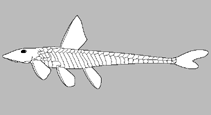Otocinclus mimulus Axenrot & Kullander, 2003
Upload your photos and videos
Google imageNo image available for this species;
drawing shows typical species in Loricariidae.
Google imageNo image available for this species;
drawing shows typical species in Loricariidae.
Classification / Names Common names | Synonyms | Catalog of Fishes(genus, species) | ITIS | CoL | WoRMS | Cloffa
Teleostei (teleosts) > Siluriformes (Catfishes) > Loricariidae (Armored catfishes) > Hypoptopomatinae
Etymology: Otocinclus: Greek, ous, oto = ear + Latin, cinclus = latticework; in allusion to the holes of the head in the ears (Ref. 45335); mimulus: Specific name derived from a Latin word, mimulus, diminutive of minus, meaning actor, given with reference to the mimicry in color pattern with Corydoras diphyes.
More on authors: Axenrot & Kullander.
Etymology: Otocinclus: Greek, ous, oto = ear + Latin, cinclus = latticework; in allusion to the holes of the head in the ears (Ref. 45335); mimulus: Specific name derived from a Latin word, mimulus, diminutive of minus, meaning actor, given with reference to the mimicry in color pattern with Corydoras diphyes.
More on authors: Axenrot & Kullander.
Environment: milieu / climate zone / depth range / distribution range Ecology
Freshwater; demersal. Tropical
Distribution Countries | FAO areas | Ecosystems | Occurrences | Point map | Introductions | Faunafri
South America: tributaries of río Monday, a right bank tributary of the río Paraná in Paraguay.
Size / Weight / Age
Short description Identification keys | Morphology | Morphometrics
Vertebrae: 22 - 23. Presence of an iris diverticulum; elevated, enlarged odontodes at posterior supraoccipital tip; lateral series 24-25; lateral line canals only on first 4-6 anterior plates in median series; lateral trunk coloration variable, including either row of 4-6 distinct dark blotches or distinct dark stripe extending from pterotic posterior process to base of caudal fin, or diffuse mixture of those two color patterns; premaxillary teeth 14-18 (commonly 15-16); mandibular teeth 12-16 (commonly 14); caudal vertebrae 15-17, modally 17; triangular pigment mark at anterior dorsal- fin base occasionally faint or absent (Ref. 52874).
Facultative air-breathing in the genus (Ref. 126274); Found in stream with dark, slightly turbid water, flowing through a landscape of mixed low forest and pasture (Ref. 52874). Collected at the margin of an open field, but the stream flowed through dense low forest left along its bank and providing shadow (Ref. 52874). Usually occurs in areas with sandy bottom, bank vegetation entering water or with marginal aquatic plants, dark, clear or slightly turbid water and limited associated fauna (Ref. 52874). Mimics Corydoras diphyes (Ref. 52874). Mimicry is unusual because the two species occupy different microhabitats and it is hypothesized to operate with a primarily visual predator moving between the microhabitats, tentatively identified as the cichlid Crenicichla lepidota (Ref. 52874).
Life cycle and mating behavior Maturity | Reproduction | Spawning | Eggs | Fecundity | Larvae
Main reference
Upload your references | References | Coordinator : Fisch-Muller, Sonia | Collaborators
Axenrot, T.E. and S.O. Kullander, 2003. Corydoras diphyes (Siluriformes: Callichthyidae) and Otocinclus mimulus (Siluriformes: Loricariidae), two new species of catfishes from Paraguay, a case of mimetic association. Ichthyol. Explor. Freshwat. 14(3):249-272. (Ref. 52874)
IUCN Red List Status (Ref. 130435: Version 2024-2)
Near Threatened (NT) (B1a); Date assessed: 03 February 2021
CITES
Not Evaluated
Threat to humans
Harmless
Human uses
FAO - Publication: search | FishSource |
More information
Trophic ecology
Food items
Diet composition
Food consumption
Food rations
Predators
Food items
Diet composition
Food consumption
Food rations
Predators
Ecology
Ecology
Ecology
Population dynamics
Growth parameters
Max. ages / sizes
Length-weight rel.
Length-length rel.
Length-frequencies
Mass conversion
Recruitment
Abundance
Growth parameters
Max. ages / sizes
Length-weight rel.
Length-length rel.
Length-frequencies
Mass conversion
Recruitment
Abundance
Life cycle
Reproduction
Maturity
Maturity/Gills rel.
Fecundity
Spawning
Spawning aggregations
Eggs
Egg development
Larvae
Larval dynamics
Reproduction
Maturity
Maturity/Gills rel.
Fecundity
Spawning
Spawning aggregations
Eggs
Egg development
Larvae
Larval dynamics
Anatomy
Gill area
Brain
Otolith
Gill area
Brain
Otolith
Physiology
Body composition
Nutrients
Oxygen consumption
Swimming type
Swimming speed
Visual pigments
Fish sound
Diseases & Parasites
Toxicity (LC50s)
Body composition
Nutrients
Oxygen consumption
Swimming type
Swimming speed
Visual pigments
Fish sound
Diseases & Parasites
Toxicity (LC50s)
Genetics
Genetics
Heterozygosity
Heritability
Genetics
Heterozygosity
Heritability
Human related
Aquaculture systems
Aquaculture profiles
Strains
Ciguatera cases
Stamps, coins, misc.
Aquaculture systems
Aquaculture profiles
Strains
Ciguatera cases
Stamps, coins, misc.
Tools
E-book | Field guide | Length-frequency wizard | Life-history tool | Point map | Classification Tree
| Catch-MSY |
Special reports
Download XML
Internet sources
AFORO (otoliths) | Aquatic Commons | BHL | Cloffa | BOLDSystems | Websites from users | Check FishWatcher | CISTI | Catalog of Fishes: genus, species | DiscoverLife | ECOTOX | FAO - Publication: search | Faunafri | Fishipedia | Fishtrace | GenBank: genome, nucleotide | GloBI | Google Books | Google Scholar | Google | IGFA World Record | MitoFish | Otolith Atlas of Taiwan Fishes | PubMed | Reef Life Survey | Socotra Atlas | Tree of Life | Wikipedia: Go, Search | World Records Freshwater Fishing | Zoobank | Zoological Record
Estimates based on models
Phylogenetic diversity index (Ref. 82804): PD50 = 0.5000 [Uniqueness, from 0.5 = low to 2.0 = high].
Bayesian length-weight: a=0.00851 (0.00374 - 0.01935), b=3.09 (2.90 - 3.28), in cm total length, based on LWR estimates for this (Sub)family-body shape (Ref. 93245).
Fishing Vulnerability (Ref. 59153): Low vulnerability (10 of 100).




